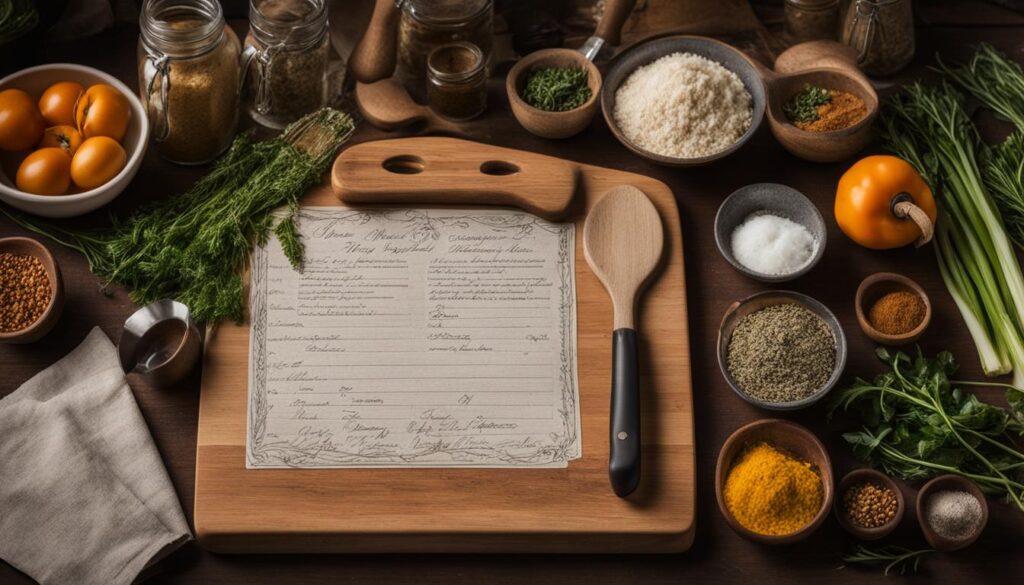We may earn money or products from the companies mentioned in this post.
Food has always played a significant role in bringing families together. Revisiting cherished family dishes can evoke memories of special occasions, holidays and family gatherings. Preserving these recipes by creating a family recipe book can be a meaningful way to keep these traditions alive for generations to come.
In this section, we will explore why creating a family recipe book is worth the effort. We’ll discuss how it can help preserve your family’s culinary heritage and the benefits of having a family cookbook for future generations to enjoy.
Key Takeaways:
- Creating a family recipe book can preserve your family’s culinary heritage for future generations.
- A family cookbook allows you to pass on cherished traditions and memories associated with each dish.
- By documenting and organizing your family’s favorite recipes, you can build a meaningful collection that can be enjoyed for years to come.
Getting Started: Gathering and Organizing Recipes
Creating a family recipe book is a fantastic way to preserve your family’s culinary heritage for generations to come. But before you can start putting together a DIY family recipe book or a family recipe binder, you need to gather and organize all the recipes you want to include.
Gathering Your Recipes
The first step is to collect recipes from the various sources you have at your disposal. Consider reaching out to family members, especially older generations, to gather heirloom recipes that have been passed down in your family. You can also check old cookbooks or recipe cards handed down from previous generations. Additionally, don’t forget to include your own favorite recipes.
When requesting recipes from family members, it’s essential to provide clear instructions on what you’re looking for and how you plan to use the recipes. This ensures that the recipe book represents a comprehensive collection of your family’s favorite dishes.
Once you have collected all the recipes, you can start organizing them into a cohesive structure.
Organizing Your Recipes
There are many ways to organize your family recipes, including using a family recipe binder or creating a digital version. Consider your preferences and choose the option that works best for you and your family.
| Option | Pros | Cons |
|---|---|---|
| Family Recipe Binder | – Easy to access – Portable – No need for electronic devices |
– Risk of losing the binder – Stains or spills can damage recipes – Limited space |
| Digital Version | – Easily shareable – Easy to store and organize – Can be accessed from anywhere with an internet connection |
– Requires electronic devices – Risk of losing data due to technical issues or hacking – Learning curve for some family members |
Once you have chosen a method for organizing your recipes, you can start inputting them and creating sections based on categories such as appetizers, entrees, desserts, etc. Be sure to include a table of contents to make it easy for readers to locate specific recipes.
Now that you have gathered and organized your recipes, you’re ready to move on to designing your family recipe book. But before we get to that, in the next section, we’ll take a closer look at the different design options available.
Designing Your Family Recipe Book
Creating a family recipe book is not just about preserving your family’s favorite dishes but also about passing down your culinary heritage to future generations. To make your family recipe book even more special and meaningful, you will want to put some effort into the design aspect of the book.
Incorporate Personal Touches
There are several ways to personalize your family recipe book. One option is to add photographs of your family members or the dishes themselves. You might even consider including handwritten notes or recipes from loved ones to make the book feel more personal and authentic.
Another way to incorporate personal touches is by experimenting with different layouts and formats. While traditional recipes are usually presented in a standard format, you might choose to be creative and use non-traditional layouts, such as a recipe presented in the format of a poem or story.
Layout Options
When it comes to designing your family recipe book, there are several layout options to choose from. Some people prefer the traditional approach of listing the recipe ingredients and instructions in a straightforward manner. Others might choose to add illustrations or even handwritten notes to make the book feel more personal.
Another layout option is to group recipes together by theme or occasion. For example, you might have a section dedicated to holiday recipes, another section for potluck favorites, and another for family dessert recipes.
Online Templates
If you’re not confident in your design skills, there are plenty of online templates available that you can use to create a professional-looking recipe book. These templates often have pre-designed layouts and graphics that you can customize to suit your needs. You might also consider hiring a graphic designer to help you create a unique and visually appealing family recipe book.
Keep it Simple
While it’s tempting to go all out on the design of your family recipe book, it’s important to remember that the focus should be on the recipes themselves. Keep the design simple and let the recipes shine. A cluttered or overly complicated layout can detract from the content and make it harder for readers to follow the recipes.
Tip: Before finalizing your design, be sure to get feedback from family members or friends to ensure that the book is easy to read and use.
Writing and Editing Tips for Family Recipes
Heirloom recipes and family cooking traditions are an essential part of any family recipe book. To ensure that these recipes are preserved accurately, it’s crucial to write clear and concise instructions. Here are some tips to help you write and edit your family recipes:
Use Clear and Simple Language
When writing a recipe, it’s essential to use language that is easy to understand. Avoid using complicated cooking terms or jargon that might confuse someone who is not familiar with the recipe. Use simple, concise sentences, and make sure to include all the necessary information, such as cooking times and temperatures.
Include Specific Measurements
One of the most challenging aspects of writing a recipe is getting the measurements right. Make sure to include specific measurements, such as cups, tablespoons, and teaspoons, and avoid using terms like “a pinch” or “a handful.” This will ensure that the recipe is reproducible and accurate.
Test and Adjust Your Recipes
Before including a recipe in your family recipe book, make sure to test it thoroughly. This will give you an opportunity to adjust the recipe as necessary and ensure that it produces the desired results. If you need to make changes, be sure to document them in the recipe so that future generations can benefit from your experience.
Capture the Stories and Memories
Along with the recipe itself, make sure to capture the stories and memories associated with each dish. These could include memories of special occasions, family traditions, or favorite times spent together. Including these personal details will make your family recipe book more meaningful and help preserve your family’s culinary heritage.
“My grandma’s chocolate chip cookie recipe always reminds me of Christmas morning when we would all gather around the tree and enjoy these sweet treats together.”
Use Photos to Enhance the Recipe
Including photos in your family recipe book can help bring the recipes to life and make them more appetizing. Take pictures of the finished dish, as well as any relevant steps in the cooking process. You can also include candid family photos to add a personal touch to your recipe book.
| Recipe Name | Photo |
|---|---|
| Mom’s Apple Pie |  |
| Grandma’s Lasagna |  |
By following these writing and editing tips, you can ensure that your family recipes are accurately preserved for future generations. Don’t be afraid to experiment and make changes to the recipes based on your own experiences. Your family recipe book should reflect your family’s unique culinary heritage and be a true labor of love.
Conclusion
In conclusion, creating a family recipe book is a labor of love that allows you to pass down your culinary heritage to future generations. By following our step-by-step guide, you can build a meaningful collection of recipes, preserving not just the flavors but also the stories and traditions that make your family’s cooking special.
Start Today
Start your journey towards creating a family recipe book today and unleash the treasure of grandma’s secret recipes for generations to come. Remember, your family recipe book will serve as a time capsule of your family’s culinary traditions and will be cherished for years to come.
Preserve Your Family’s Legacy
By taking the time to create a family recipe book, you are preserving your family’s legacy and ensuring that future generations will be able to enjoy the same foods and flavors that you grew up with. Whether you choose to create a DIY family recipe book or a digital version, make sure to include personal touches and stories that make your family’s cooking unique.
A Gift for Your Family and Future Generations
A family recipe book is also an excellent gift idea for weddings, birthdays, or any special occasion. Your loved ones will cherish the time and effort you put into creating it, and it will be a treasured family heirloom for years to come.
Happy Cooking!
We hope this guide has inspired you to create your own family recipe book and preserve your family’s culinary heritage. Happy cooking!
FAQ
Why is creating a family recipe book important?
Creating a family recipe book is important because it helps preserve your culinary heritage and allows you to pass down your family’s favorite recipes to future generations.
How do I gather and organize recipes for my family recipe book?
To gather and organize recipes for your family recipe book, you can collect recipes from family members and other sources. You can also use a family recipe binder or create a digital version for easy organization.
What are some design tips for creating a family recipe book?
When designing your family recipe book, you can choose from various layout options, including traditional formats and more creative approaches. You can also incorporate personal touches and photographs to make your recipe book unique and meaningful.
How can I write clear and concise instructions for family recipes?
To write clear and concise instructions for family recipes, it is important to follow writing and editing tips specifically tailored to family recipes. Additionally, capturing the stories and memories associated with each recipe helps preserve family cooking traditions.
What is the significance of creating a family recipe book?
Creating a family recipe book allows you to preserve not just the flavors but also the stories and traditions that make your family’s cooking special. It is a labor of love that ensures future generations can recreate the dishes accurately.
Affiliate Disclosure: This post may contain affiliate links. If you purchase through our link, we may receive a small commission, but at no additional cost to you. For more information, please see our Disclosure statement.



